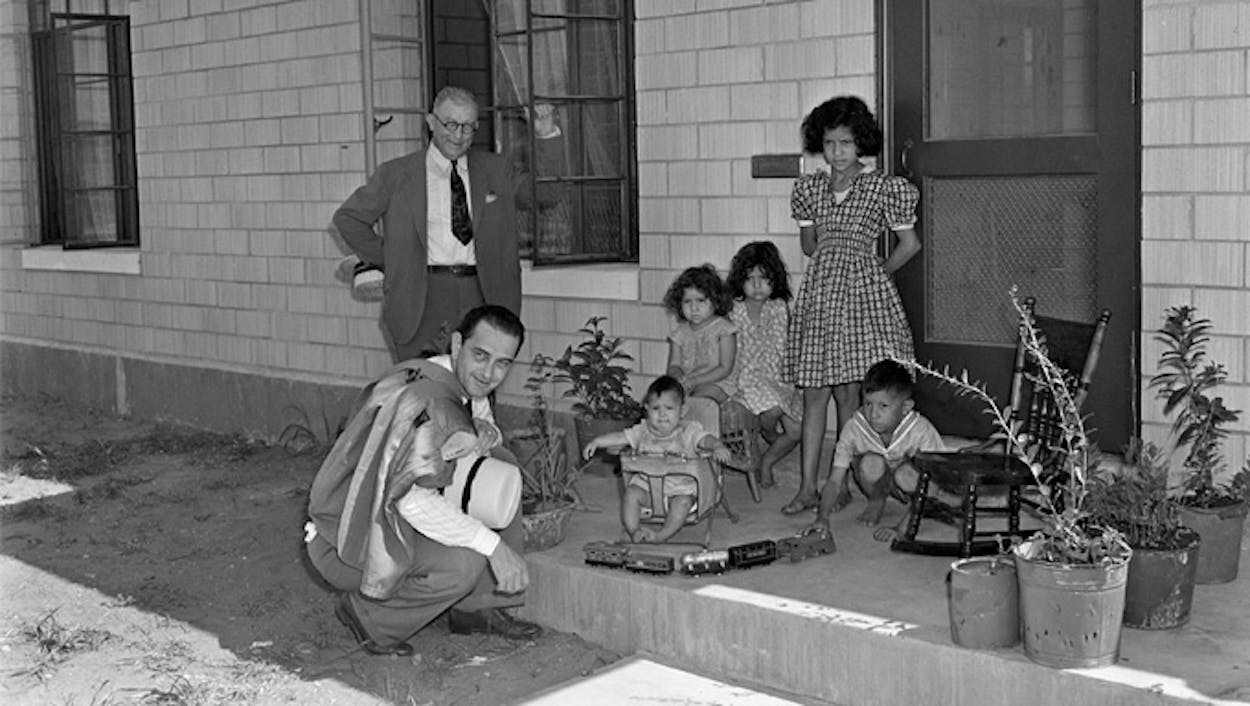Long before Austin became a bustling hub of live music, technology, and food trucks, it was a simple capital city, dominated by politicians and lobbyists. That city, on the eastern edge of the Hill Country, was the Austin of Lyndon Baines Johnson’s day. Though Johnson didn’t live in Austin for much of his life, the city made a mark on the president from a young age. He was only 10 when he began accompanying his father, a state representative, to the Capitol, where he became enchanted by the legislative process. “I would sit in the gallery for hours watching all the activity on the floor and then would wander around the halls trying to figure out what was going on,” he told his biographer, Doris Kearns Goodwin.
Johnson returned to the city frequently for the rest of his life—often for politics, but also for refuge. “As soon as father landed in Austin, he began to feel relief,” said Luci Baines Johnson, 65, the president’s youngest daughter. “Two days in the Hill Country did more for his soul than two weeks in the Caribbean would’ve done.”
Forty-two years ago, on May 22, Johnson’s Presidential Library and Museum opened its doors in Austin—a fitting culmination to his political and personal history with the city. “I know he was proud to be part of the community,” Ms. Johnson said.
Even though Johnson, who died in 1973, would barely recognize modern Austin, landmarks of his life remain. Some may look unremarkable, but with a little background, it is possible to imagine the Austin that Johnson knew.
Driskill Hotel
604 Brazos St.
On the morning of September 6, 1934, Johnson, then a young congressional secretary, sat alone by the window of the Driskill Hotel’s dining room. Claudia Taylor, better known as “Lady Bird,” hesitantly walked inside and sat down for her first date with the future president.
Their breakfast stretched into a daylong car ride and ended with a marriage proposal from Johnson. Though Lady Bird thought he was “out of his mind” and declined, the two began corresponding daily once Johnson returned to Washington. Ten weeks later, after constant pleading from Johnson, the couple married on a whim in San Antonio.
The Johnsons—whose marriage was enduring, if not as idyllic as their courtship—stayed in the Driskill Hotel many times. Room 434, a fourth-floor suite with a balcony overlooking Sixth Street, was permanently reserved for the president. In November 1948, 1960, and 1964, the Johnsons gathered with friends and supporters in the hotel’s Jim Hogg Parlor to watch the election returns come in.
The 127-year-old Driskill Hotel, recently acquired by Hyatt, is the oldest operating hotel in Austin today, with walls “just steeped in history,” as Lady Bird once gushed. The dining room where the Johnsons had their first date is now the Driskill Grill.
 President Lyndon B. Johnson watches television sets in the Driskill Hotel as elections returns are reported on election night in 1964. | LBJ Library Photo, Cecil Stoughton
President Lyndon B. Johnson watches television sets in the Driskill Hotel as elections returns are reported on election night in 1964. | LBJ Library Photo, Cecil Stoughton
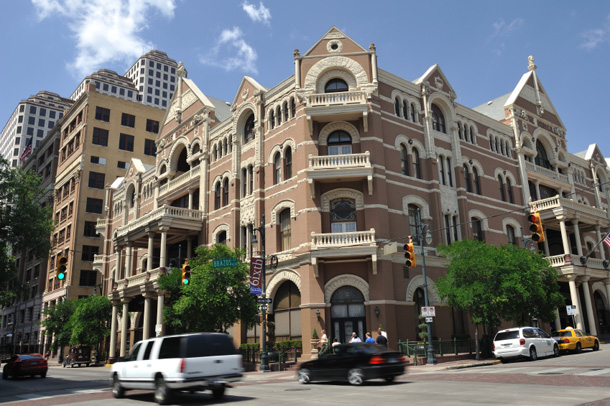 The Driskill Hotel in downtown Austin, Texas in April 2012. | iStockphoto
The Driskill Hotel in downtown Austin, Texas in April 2012. | iStockphoto
Littlefield Building
601 Congress Avenue
Today the Littlefield Building in downtown Austin is dwarfed by the Austonian and Frost Bank Tower, but in 1935, when Johnson occupied a sixth floor office as statewide director of Texas’ National Youth Administration, it loomed over the small city. At the helm of the NYA, a New Deal program designed to provide youth with part-time work and keep them in school, Johnson saw for the first time that he could improve people’s lives through government.
At 26, Johnson was the youngest of the 48 state NYA directors but faced one of the biggest challenges: adapting a rigid federal program to sprawling and diverse Texas. He urgently set up shop the Monday after his appointment in three cramped offices in the Littlefield.
He and his small staff worked everyday from 7:30 a.m. until after midnight. When the Littlefield’s electricity was shut off promptly at 10:30 every night, they would continue work by gaslight and finally stumble down the six flights of stairs in darkness. Johnson’s dedication did not go unnoticed. In 1936, Eleanor Roosevelt paid a visit to the Littlefield Building to see for herself how Johnson “was doing such an effective job.”
Though Johnson left the NYA after a year and a half to run for congress, Lady Bird has said it was “some of the best years of [their] lives.” She described the ambiance of that period as one of “youth, vitality, high hopes, and determination.”
Today the sixth floor of the Littlefield is occupied by a law firm and a bank.
 Left: The Littlefield Building in the 1920s. Harry Ransom Center | E. O. Goldbeck Collection. Right: The Littlefield Building in September 2010. | Flickr , BIG MAN SE3
Left: The Littlefield Building in the 1920s. Harry Ransom Center | E. O. Goldbeck Collection. Right: The Littlefield Building in September 2010. | Flickr , BIG MAN SE3
The Johnsons’ Residence
2808 San Pedro St.
Lady Bird always thought their temporary home on San Pedro Street was “romantic and charming.” The young couple rented it from Dr. Robert Montgomery, an eccentric economics professor and acquaintance, who had taken a leave of absence just as Johnson began his stint with the NYA.
At times, the monolithic, concrete structure seemed to burst at the seams with visitors. Staff would come and go, sometimes staying for a meal, other times settling in for three weeks. Jesse Kellam, a staff member who would succeed Johnson as director, was a frequent guest and would tell Lady Bird she could “fix spinach in a way that he never had eaten it before.”
After late nights at the Littlefield, the work did not end. Often staff would rendezvous in the Johnsons’ large backyard to parse the latest bulletin from Washington by lantern light. For two NYA staff members, who rented a spare room in the house, one workday would bleed into the next—Johnson was known to yell up the stairs about unfinished business at all hours of the night.
“I’d be almost afraid to go back and see it now,” Lady Bird once said, for fear “the lens of the years” had skewed her fond memories of the place. Some 78 years later, the house, now home to four college students, looks much the same, except for a few beer cans scattered in the yard and a Longhorn flag hanging in the front. Though he didn’t use Lady Bird’s word “romantic,” Sam, one of the occupants, said they do enjoy the balcony—where they’ve hung a hammock chair and a basketball hoop—and the expansive, multilevel backyard. When informed that the Johnsons had once lived in their house, Sam responded matter-of-factly: “we know.”
 The house at 2808 San Pedro in 1936. The Johnsons lived in this Thermocrete house in 1935-1936 while LBJ headed the Texas office of the National Youth Administration. | Austin History Center, Austin Public Library
The house at 2808 San Pedro in 1936. The Johnsons lived in this Thermocrete house in 1935-1936 while LBJ headed the Texas office of the National Youth Administration. | Austin History Center, Austin Public Library
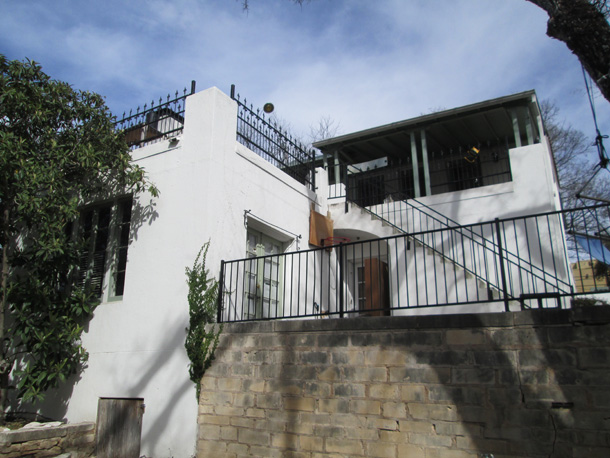 2808 San Pedro in March 2013, 78 years after the Johnsons moved in. Four college students now enjoy the backyard and patio that Lady Bird once did. | Photo by Madelyn Herzog
2808 San Pedro in March 2013, 78 years after the Johnsons moved in. Four college students now enjoy the backyard and patio that Lady Bird once did. | Photo by Madelyn Herzog
Santa Rita Courts
2341 Corta St.
On Christmas morning, during his first year as congressman from Texas’s 10th District, Johnson woke before dawn and ventured into impoverished East Austin, where he carefully counted each of the outdoor toilets. His jaunt through Austin’s slums left a lasting impression on him and after President Roosevelt signed the 1937 Wagner-Steagall Housing Act creating the United States Housing Authority, Johnson was the first to apply for and receive a federal loan.
Despite local opposition and wariness of government interference in the private rental market, Johnson prevailed. In 1939, the nation’s first public housing project was erected in East Austin. The 40 units, with rents ranging from $10.20 to $11.70 a month including utilities, were built specifically for Mexican families. (Separate projects for African-Americans and whites followed soon after.) Johnson proudly attended the opening and posed with the first families moving in. As she explored her clean, new apartment, a young resident memorably observed, “No bugs,” the Austin American-Statesman reported.
Santa Rita expanded to 97 units in 1951, and vacancies never last more than a week, according to the building manager.
Elaine Sandoval has lived in unit 2408 for over a decade with her small grandchildren. “We love it here,” Sandoval, 42, said. In contrast to the unadorned apartments on either side, Sandoval’s small front yard explodes with flowers, small trees, and statuettes. Her 23-year-old daughter, Ashley, said people often stop by clutching a famous image of Johnson in front of her mother’s unit. The Sandovals keep their own copy of the photograph inside.
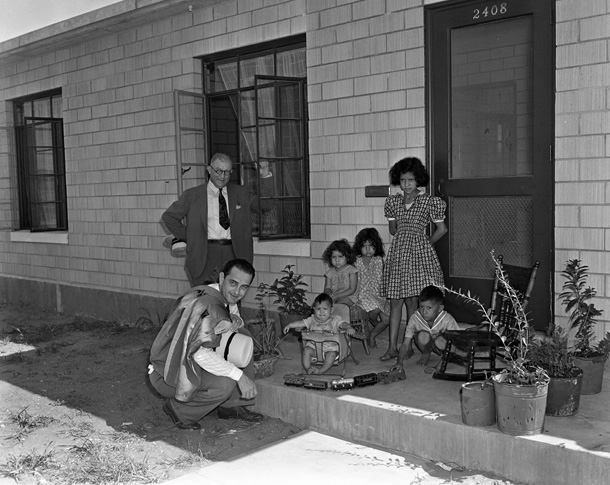 Congressman Lyndon B. Johnson visits a family at the the Santa Rita Housing Project in September 1939. | LBJ Library Photo by Neal Douglass
Congressman Lyndon B. Johnson visits a family at the the Santa Rita Housing Project in September 1939. | LBJ Library Photo by Neal Douglass
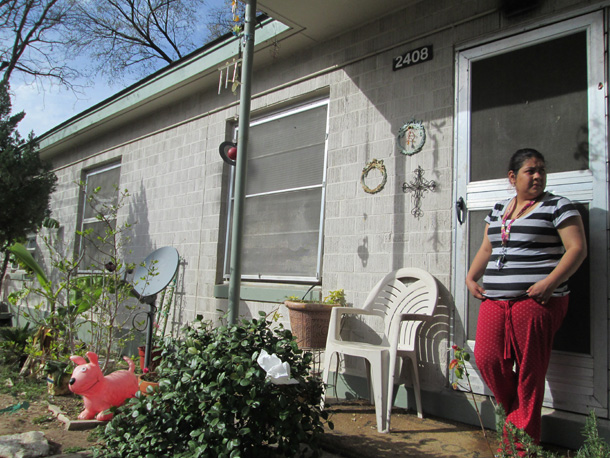 Ashley Sandoval, 23, stands outside Santa Rita’s unit 2408, where her mother lives. | Photo by Madelyn Herzog
Ashley Sandoval, 23, stands outside Santa Rita’s unit 2408, where her mother lives. | Photo by Madelyn Herzog
- More About:
- Texas History
- Politics & Policy
- LBJ
